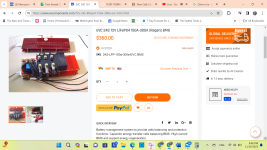BTW, here's a JBD contactor-based BMS; since it doesn't use FETs for switching access to the cells it should be able to do whatever regen current you want. (I haven't read it's manual, so you'll have to verify it's actually able to do what you want).
Jiabaida BMS JBD Smart BMS 3S 4S 12V 60A 80A 100A 120A 150A LiFePO4 Battery PCB With Balance Uart Optional RS485. High quality better service and favorable price with free shipping. Battery Management System for NMC/Li-ion Lifepo4 battery

jiabaidabms.com
So that planned 6kw hub motor might draw 10-12kw, and 6kw+ on regen. That would only be for short bursts up and down.
I hope you are going to use a controller with variable (controllable) braking force via your brake lever or throttle. If you use one that is just on/off, I'd bet on snapping the motor axle or frame or dropouts at some point from the shock loads.
Going to be a hell of a battery that can do that kind of power level for charging / regen current.

Let's say that's at 72v, you'd need one that can handle 166A discharge current, and 84A charging current.
How long a runtime do you need? At those wattages, if used anywhere near those rates, I expect you're looking at high wh/mile usages, like 100wh/mile or more. Let's assume you need to go 20 miles; that's 2kwh (call it 30Ah), call it 35-40lbs of battery depending on cells, casing, supports, etc, and probably a block as big as a good stack of trade paperback books. (in whatever shape the cells allow). If you need 40 that's 4kwh (call it 60Ah), and twice as large, heavy, etc.
That's assuming you can find cells at that low a capacity that can accept multi-C-rate charging. If the cells can only handle 0.5C charging or less as is common enough, then to get 84A of regen current forced into them without stressing them, you'd need cells that have twice that as capacity, or 168Ah or larger cell (or parallel groups of smaller cells equalling that).
If you're stuck with that size of cell(group), that leaves you with a 72v x 168Ah = 12kwh pack. Good news is that would give you a one hour runtime at full discharge rate of 12kW, but bad news is that's a gigantic battery, probably weighing upwards of 100lbs (or more including enclosure, etc).





